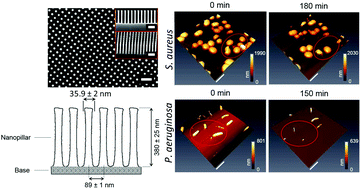The idiosyncratic self-cleaning cycle of bacteria on regularly arrayed mechano-bactericidal nanostructures†
Abstract
Nanostructured mechano-bactericidal surfaces represent a promising technology to prevent the incidence of microbial contamination on a variety of surfaces and to avoid bacterial infection, particularly with antibiotic resistant strains. In this work, a regular array of silicon nanopillars of 380 nm height and 35 nm diameter was used to study the release of bacterial cell debris off the surface, following inactivation of the cell due to nanostructure-induced rupture. It was confirmed that substantial bactericidal activity was achieved against Gram-negative Pseudomonas aeruginosa (85% non-viable cells) and only modest antibacterial activity towards Staphylococcus aureus (8% non-viable cells), as estimated by measuring the proportions of viable and non-viable cells via fluorescence imaging. In situ time-lapse AFM scans of the bacteria–nanopillar interface confirmed the removal rate of the dead P. aeruginosa cells from the surface to be approximately 19 minutes per cell, and approximately 11 minutes per cell for dead S. aureus cells. These results highlight that the killing and dead cell detachment cycle for bacteria on these substrata are dependant on the bacterial species and the surface architecture studied and will vary when these two parameters are altered. The outcomes of this work will enhance the current understanding of antibacterial nanostructures, and impact upon the development and implementation of next-generation implants and medical devices.



 Please wait while we load your content...
Please wait while we load your content...